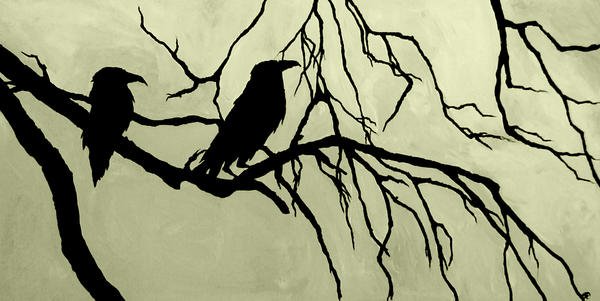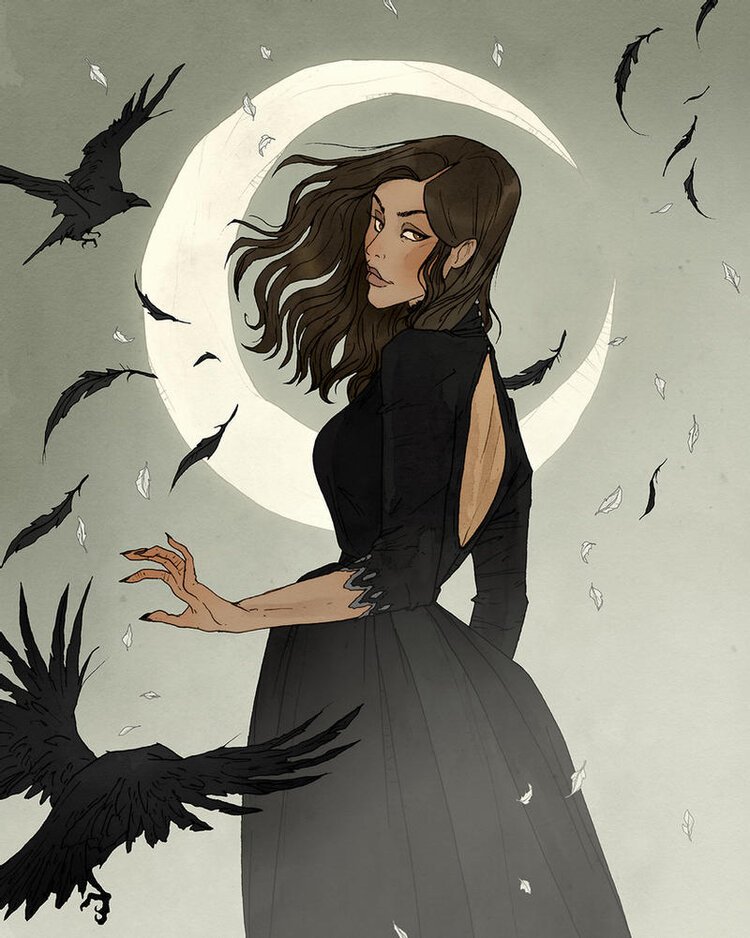The Wisdom and Knowledge of the Shrewd Raven: Symbolism and Insights from Mythology
“For more than 12 million years, crows and ravens have applied their splendid intelligence to the art of living by their wits. They are master opportunists. They seek and find. They take, or thieve. They don’t necessarily wait for doors to open or anything else to be opened unto them; they do it themselves, with their stout, knifelike beaks.”
The Symbolism of the Raven in myth
Throughout history, ravens have captured the imagination and wonder of people across various cultures and traditions, their symbolism weaving a tapestry of meaning that varies based on context. At the core of their significance, the raven is a creature of remarkable adaptability, intelligence, and problem-solving ability, serving as a symbol of wisdom in many cultures.
(image on the left from Pixabay)
In some cultures, ravens symbolize death and the afterlife and are believed to guide souls to the underworld and act as emissaries of the god of death. In this vein, ravens are viewed as creatures of magic and mystery, messengers between the mortal and divine worlds.
Yet, in other traditions, the raven is a trickster, a mischievous creature that delights in causing chaos and playing pranks on unsuspecting humans. Despite this, the raven is also seen as a protective spirit, watching over and guiding humans in certain cultures.
In essence, the raven's symbolism is a complex tapestry of meanings that has fascinated people for generations, serving as a mirror to our fears, hopes, and dreams.
The Raven and Odin in Norse Mythology
Odin’s Ravens, Thought and Memory, by Abigail Larson (@abigail_larson)
In the realm of Norse mythology, a bird with a voice akin to human speech soared through the skies, leaving the people in awe of its wisdom. It was no wonder the Norse believed this feathered creature possessed all-encompassing knowledge. Thus, the one-eyed All-Father Odin was gifted two ravens as companions, Huginn and Muninn, representing Thought and Memory, respectively.
The ravens would venture forth each day to observe the land of humans, only to return at nightfall and whisper all their discoveries to Odin. It was as if these birds were the eyes and ears of the wise Raven God, who would gather all the knowledge he could for the betterment of his people.
But Odin's bond with the ravens extended beyond mere companionship. His valiant daughters, the Valkyries, would descend from the heavens as ravens tasked with scouring the battlefield for the chosen warriors who had earned a place in Valhalla.
While the Valkyries have been predominantly portrayed on horses in nordic legends, it is noteworthy how ravens have earned a place in our collective psyches as scavengers, with numerous illustrations of them in art with their dark wings casting a shadow over the aftermath of battles, scavenging the remains.
The Raven and The Morrigan in Irish mythology
In ancient Irish mythology, a formidable goddess existed, revered, and feared in equal measure. She was none other than The Morrigan (Mórrigan), the embodiment of war and fate. But she was not content with simply observing battles from afar. No, she took to the skies in the form of a raven, soaring above the battlefield with a sinister grace.
As the raven she would swoop down, her presence igniting both fear and courage in the hearts of the warriors below. Her power was not just limited to instilling emotions, however. She was known to sway the very outcome of battles, using her ethereal form to strike fear into the enemy ranks and bolster the morale of her own.
(Illustration of The Morrigan by Iren Horrors (@irenhorrors))
To encounter the Morrigan in her raven form was a sign of impending doom, for she was the personification of looming death itself. In one myth, the Morrigan appears to the hero Cú Chulainn as a raven and warns him of his impending death. But for those who earned her favor, she could be a valuable ally in the art of war. Such was the power of this ancient goddess, whose legend still echoes through the ages.
Diablo, Maleficent's Raven
The art of shapeshifting has been a long-standing tradition for witches, granting them the ability to transform into creatures like ravens, allowing for secret and swift transportation to their gatherings.
(Illustration of Maleficent and Diablo by Iren Horrors (@irenhorrors))
Meanwhile, in the realm of animated fantasies, one cannot forget the enchanting presence of Maleficent, the Mistress of All Evil, and her loyal raven companion, Diablo. Together, they captivated audiences with their dark allure, becoming some of the most beloved characters to grace Disney's animated masterpieces.
The Raven in Welsh mythology & the hero Brân the Blessed
The ravens at the Tower of London are not merely birds but symbols of fortitude and security. According to ancient legend, as long as they roost in the Tower, the realm would remain unassailable by hostile forces.
(Image on the left from Pixabay)
This belief is so deeply ingrained in the British identity that during the Second World War, even Winston Churchill had ravens transported from Scotland to ensure their continued presence at the Tower when their numbers dwindled.
This mythic connection between ravens and protection is rooted in the Welsh hero Brân the Blessed, whose name translates to raven or crow. He was known as the keeper of ancestral memories, a powerful and wise figure whose spirit remains present in the form of these dark-feathered birds.
The Raven in Ancient Greece
In ancient Greece, the raven was highly regarded for its connection to the god Apollo, the all-seeing and prophetic deity of the sun.
In the myth, all ravens once possessed a pure white coat, but this all changed when the raven brought tragic news to Apollo about his lover Coronis. Enraged, Apollo struck the messenger bird. Its once-white feathers turned black, forever marking the raven's feathers with a somber hue.
While the raven was initially linked to the wise goddess Athena, the owl later replaced it as her trusted and insightful companion. Yet, the raven's significance in Greek mythology remains as a symbol of prophecy, change, and even death, a creature with a dark allure that has captivated the imagination for centuries.
The Raven as a Helper of Humanity
The raven, often associated with malevolence, is portrayed differently in various cultures worldwide.
In the biblical account of Noah's story, the raven was dispatched to scour the vast expanse in search of habitable land but neglected to return, thus earning a disreputable reputation as no ally of humanity. Yet, when the dove was dispatched next, it triumphantly accomplished its mission of locating the precious olive branch, rendering it an opportune harbinger in the eyes of many.
On the other hand, Viking explorers sent out ravens in search of new land and regarded them as helpers of humanity. Similarly, in the Mahabharata, the raven is viewed as a messenger of death without the ill-fated connotation often present in Western tales.
The Raven in Indigenous Cultures
The Indigenous peoples of the Americas view the raven as a mighty guardian of humankind and a symbol of the Creator. The raven is credited with crafting the universe and finding and looking after the first human in various myths. It is the favored bird of shamans who converse with the birds to discern what the gods are planning for humanity.
The Raven in Haida legend
Specifically, in the mythos of the Haida people in the Pacific Northwest, there exists a figure of great power and cunning, a being of unparalleled wit and guile known as the Raven. According to the stories passed down through the generations, the Raven brought light to the world, shattering the darkness that once shrouded all creation.
In the beginning, the world was cloaked in shadow, and the Raven was restless. So, driven by an unquenchable curiosity, he took flight on his mighty wings, soaring up towards the heavens in search of a way to pierce the gloom.
(Image on the left from Pixabay)
And it was there, high above the earth, that he discovered the source of all light and warmth: the sun, the moon, and the stars.
Without hesitation, the Raven snatched up these glowing orbs in his beak and talons, clutching them tightly as he returned to the world below. Then, with a deft and graceful touch, he placed the sun in the sky and the moon in the night and scattered the stars across the heavens like a jeweled cloak.
But the Raven was not content to simply create the world anew. He was also a trickster, a being of insatiable curiosity and a penchant for mischief. In one tale, he played a clever trick on a greedy village chief, disguising himself as a helpless baby and convincing the chief's daughter to take him in as her own.
Once safely ensconced in the chief's household, the Raven stole treasures and food, outwitting the chief at every turn. And when he was finished, he revealed his true form once more and took to the sky, leaving the befuddled chief to wonder at the power of the Raven's cunning.
And yet, for all his mischievousness, the Raven was also a bringer of great gifts to the people. He was the one who first brought fire to the world, stealing it from the spirits themselves and teaching humanity how to harness its power for warmth and cooking.
In this way, the Raven symbolizes creativity and trickery, the power to create, and the drive to explore.
As different tribes honor the raven uniquely, the lore surrounding this majestic bird adapts to reflect the varying beliefs and traditions. This comprehensive article is an excellent resource for delving into the myriad of stories associated with the raven in Indigenous beliefs.
The Raven in Ancient Egypt
The raven's role as a guardian of the deceased is a recurrent theme in ancient Egyptian mythology. Nephthys, the goddess of the dead and overseer of funerary rites, is often depicted with the crow or raven as one of her symbols.
Nephthys is wedded to her brother Set, the god of war and chaos, and the mother of Anubis, the god of death and mummification, whose father is Osiris, Set, and Nephthys's brother - complicated family ties! Although Nephthys is usually portrayed with falcon wings, in some representations, the raven or crow is her trusted companion, standing by her side as she guides souls to the afterlife.
Ravens, Crows, and Crones
The connection between ravens, crows, and wise older women is a recurrent theme worth highlighting. Western society tends to idolize youth and beauty while stigmatizing aging. This bias is reflected in our folklore and stories.
(Illustration of Baba Yaga by Iren Horrors (@irenhorrors))
Consider the Slavic witch Baba Yaga, infamous for her solitary existence in the forest and ability to shapeshift into a crow. She embodies the cunning and wisdom of nature, like her trusted crow companion.
The Hindu goddess Dhumavati, on the other hand, is associated with death and transformation, and her portrayal as a fearsome old crone is remarkable. She is often seen riding a chariot pulled by crows or perched atop a crow, which serves as her animal guardian.
It is intriguing to observe how the concepts of old age and ugliness are intertwined. Nevertheless, in myths and fairy tales, we see the power of wise older women and their raven/crow counterparts as they represent the duality of death and new beginnings. Without these "old crows," life's transmutation and regeneration would not occur.
Inviting the Raven Within
As we journey through life, we are presented with many symbols that carry hidden meanings and messages. These symbols can come in many forms - chance encounters with a particular animal, a series of recurring numbers, or even an unusual pattern in the clouds above. And yet, amidst the hustle and bustle of daily life, it can be all too easy to overlook these signs and their deeper significance.
Illustration by Abigail Larson (@abigail_larson)
But if we choose to pay attention, pause, and connect with ourselves in these moments, we could open ourselves up to a wealth of insight and wisdom. Every symbol we encounter is a personal invitation to reflect on our life journey and contemplate how these mysterious messages might hold meaning for us on a deeper level. Explore the essence of the raven and find words that encapsulate its essence. These words may unlock the secrets of their visit and provide valuable insights into your journey.
What might ravens mean to you personally?
How have ravens made their presence known in your life?
Have they graced your dreams with their enigmatic wisdom?
If so, what message might they be trying to impart?
Warmly,
Anny
Kindly note: The information included in this blog is not intended nor implied to be a substitute for mental health services. Please consult with a qualified professional to determine the appropriateness of the information for your own life experiences or if you have any questions.








